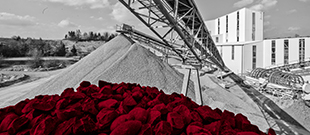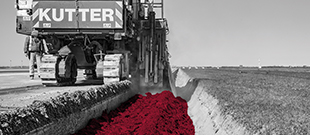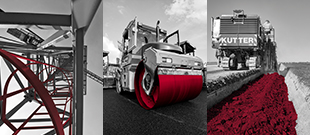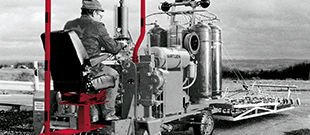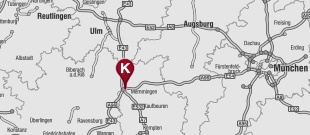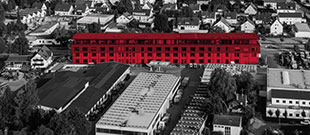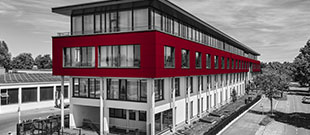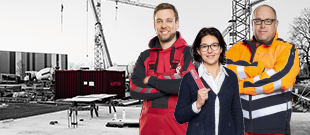Think about tomorrow today
KUTTER not only stands for an efficient and modern way of working, but also always has the environment in mind. With a wide variety of technologies, we are careful in every area to work as resource-saving and climate-friendly as possible. With the Green Shovel we mark special projects and processes, because as a construction company we are aware of our responsibility towards our planet.
On this page you can see where we are already thinking about tomorrow and which processes are used.
KUTTER PHOTOVOLTAICS
POWER FOR THE FUTURE
Sustainable management has long since gone beyond ambitious climate targets. A successful energy transition can only succeed if every aspect of a company is examined. KUTTER has been facing up to these challenges for decades thanks to its in-house energy management system in accordance with ISO 50001; an example of this is the generation of electricity via photovoltaic systems on the company roofs. Every kilowatt hour of solar power replaces the same amount of conventionally generated energy and thus counteracts global warming.
Some of our subsidiaries and affiliated companies have been successfully generating solar power for several years. Bituleit Leipzig's photovoltaic systems produce around 50% of the total consumption at the site. About 41% of the electricity generated can still be fed into the public grid. At Hans Hebel in Darast, about 41% more is produced than is consumed in total; here approx. 57% of the solar power produced can be fed into the grid. At the KUTTER location in Leipzig, around 28% of the total consumption is generated by photovoltaics and around 30% of the electricity produced is fed into the grid. The leader is our subsidiary RAZ in Rückholz, which produces around 99% more electricity than is consumed at the site. About 67% of the electricity generated is fed into the public grid. The electricity fed into the grid at all locations roughly corresponds to the energy consumption of around 380 single-family homes per year.
Further plants are planned for 2023 in order to expand our joint efforts towards more climate protection in the future. Our KUTTER locations in Bad Wörishofen, Darast and Eschenlohe as well as BK-Kies in Bad Wörishofen and Bituleit in Kaufering are equipped with a photovoltaic system.
RESOURCE CONSERVATION IN PRACTICE
USING THE EXAMPLE OF THE MAJOR PROJECT AT LEIPZIG AIRPORT
The renovation of the northern runway at Leipzig Airport is a prime example of KUTTER's sustainable, resource-saving and climate-friendly work. The major project came about because the concrete reinforced with welded wire mesh was irreparably damaged.
In just 30 days, the 3,600 m long runway, including the associated runways/taxiways, had to be completely removed in several layers. This resulted in a daily workload of 1,100 t of concrete per cutter. Therefore, 12 KUTTER concrete cutters were in use at the same time every day.
Concrete milling is a technology that has established itself worldwide. Not only the environmentally friendly demolition of old concrete with dowels, anchors and steel mats can be carried out without any problems, but also the selective removal, which enables the separation of different concrete layers and the associated reduction of pollutant material. In Leipzig, too, the old concrete can and could be 100% recycled after previous selective removal by our milling machines.
The granulated concrete was temporarily stored near the construction site and then used for the further expansion of the airport. This interim storage in the immediate vicinity of the construction site prevented long truck transport routes and at the same time kept the need for new material to a minimum.
In addition, the cold milling machines are equipped with a wide range of environmentally friendly machine technology. For example, the Mill Assistant controls the speed ranges in milling operation in a way that optimizes consumption over the long term, and the fan speeds are controlled by the engine temperature. In addition, the automatic activation and deactivation of the water spraying system as well as the water dosing depending on the milling performance significantly reduces the specific water consumption during the milling work.
In order to create precise forecasts for the consumption of wear parts, for example, practical application tests were carried out eight months before the start of the construction site. It was possible to work efficiently and in an environmentally friendly manner throughout the entire project, and this was completed within the planned time window with optimal milling results. The combination of expertise and technology resulted in a carbon footprint that is impressive.
RECYCLING OF BUILDING MATERIALS
THE FUTURE OF THE CONSTRUCTION INDUSTRY
Source AZ from 04/11/2023
Whether road construction, track construction, industrial or residential construction: huge amounts of gravel are used everywhere. However, like any other raw material, gravel is also a valuable commodity that is becoming increasingly scarce. In southern Germany, thanks to the ice age, there are still huge amounts of it slumbering in the ground, but it is becoming increasingly difficult for construction companies to get new gravel pits approved. Recycling is becoming increasingly important. This in turn is also good for the environment. Our subsidiary, the Result-Recycling GmbH & Co. KG ensures regional cycles and helps to avoid long transport routes and thus protect the climate.
The company is dedicated to the demolition, recycling and disposal of building materials, which is becoming an increasingly important issue in Europe and the world because in the foreseeable future there simply won't be enough pits to dump construction waste into. Also, sand and gravel are not infinitely available, as has long been believed. 100,000 tons of material from demolished buildings, roads and rail tracks come together at the Bad Wörishofen site every year, half of which goes back into the construction cycle as valuable building material.
The decisive factor here is that the material is separated by type as far as possible. This can also be clearly observed on the company premises in Bad Wörishofen. Different material is stored on different piles of rock, such as track ballast, rubble, or concrete. During demolition work, great care is taken to ensure that the materials are separated as well as possible. D-mixtures, on the other hand, are hardly easy to recycle. Pure material, i.e. so-called substitute building materials, can be used well in new buildings. Builders would have to confirm where the demolition material came from. This is important in order to rule out contaminated material being smuggled in. In cooperation and cooperation with employees of the Technical University of Munich, we monitor each batch and take samples regularly.
In any case, the ballast from the railway tracks is loaded. This is due to the pesticides that have to be used to prevent the tracks from becoming overgrown. This material can also be recycled, which is why Result-Recycling will set up a floor washing plant on the company premises in Kaufering in the foreseeable future in order to expand recycling even further.
From the point of view of the district, the company Result-Recycling in the Lower Allgäu is one of the model companies in environmental protection. We are pioneers here. Three kilograms of carbon dioxide can be saved per tonne of recycling material. With an annual volume of 50,000 tons, that means 15,000 kilograms of carbon dioxide. Strong performance, what the RESULT-Recycling team creates! Thanks a lot for this.
WE DRIVE WITH HVO
our vehicle fleet is also becoming sustainable
It is very important to KUTTER to conserve energy and its resources. Since KUTTER is already quite well positioned in many areas, it was important for us to take a closer look at our largest source of energy, namely the KUTTER fleet and the mixing plants, and to look for a way to make them future-proof and energy-efficient. In order to act in a sustainable and resource-saving manner, we have to significantly reduce the amount of fossil fuels used.
We came across the topic of HVO and the Finnish company NESTE, which produces a sustainable fuel. This is mainly obtained from renewable raw materials, fatty acids, residual and waste materials as well as municipal waste - the whole thing is called HVO, which stands for Hydrotreated Vegetable Oils. What this is all about in detail is explained to us by Dr. Markus Mohrdieck, Head of Safety and Environment at the KUTTER Group, in this video.
Unlike biodiesel
However, anyone who now thinks of a type of biodiesel when it comes to HVO is wrong! Chemically, HVO is absolutely identical to fossil diesel, which is obtained from crude oil using refinery processes. HVO does not contain any aromatics, which contribute significantly to fines pollution. CO2 emissions with NESTE fuel are reduced by 90%. This is due to the use of regenerative raw materials. The emitted carbon circulates in NESTE HVO fuel. The new fuel is not yet approved in Germany, but it can be used in company-internal refueling under certain conditions. Currently, use is mainly limited to heavy commercial vehicles and public fleets. In the first step, KUTTER is planning the more climate-neutral HVO fuel for various vehicles of different sizes, so that KUTTER's CO2 footprint is significantly reduced.
The benefits are enormous
The HVO fuel even offers advantages over the commercially available – i.e. fossil – diesel. It is odourless, can be stored for a very long time and has a "better" water hazard class (WHG I) than conventional diesel. This means that significantly lower requirements have to be placed on storage. Thanks to its clean combustion, we hope to reduce the maintenance intervals for vehicle exhaust gas cleaning. Even cold winters, which are common in the Allgäu, our vehicles with HVO survive better, since conventional diesel often thickens in cold temperatures and thus clogs the filters. Another advantage is that the new fuel is compatible with fossil diesel, which means that the other fuel could also be refilled. For us, all of this outweighs the higher specific price, because KUTTER is making an important contribution to the future.
Why doesn't KUTTER rely entirely on electromobility?
When it comes to cars, KUTTER uses electromobility wherever possible. However, electromobility cannot (yet) be applied to heavy-duty or commercial vehicles. Furthermore, the charging infrastructures on construction sites are not yet available. As a company, we are simply convinced that the energy transition cannot be achieved simply by concentrating on e-mobility or even hydrogen.
Open to new
We are pleased that we have found partners in NESTE and the distributor EDI with whom we can operate our fleet in a future-proof and resource-saving manner and we continue to strive in all areas of the company to create sustainable solutions.
save resources
From old to new
Our goal is to be able to convert as much old asphalt granulate as possible into new asphalt mix. So we not only practice recycling, but always strive for a suitable upcycling by processing between 50 - 100% old asphalt. This is made possible by proactive demolition work, in which we rely on milling in layers, even if it was not advertised by the client. Thanks to the modern plant technology in the asphalt mixing plant, e.g. B. a parallel drum and an increased sampling and analysis effort in our own laboratories, this project can be implemented expediently.
REDUCING CO2-EMISSIONS IN ASPHALD PRODUCTION
WE REDUCE CO2 EMISSIONS BY APPROX. 10%
Dry storage (indoor storage) of recycling materials (smaller than 8 mm in diameter) reduces CO2 emissions during asphalt production by around 10%. The halls are used to keep the used asphalt in the form of milled material that is to be mixed in during the asphalt production process dry and warm; the incineration process therefore requires significantly less energy and fewer raw materials are used. Storage is often in tents; However, we made a conscious decision to build halls so that the roof areas can optionally be covered with a PV system.
LOW-TEMPERATURE ASPHALT
THE COOL AMONG INSTALLATIONS
In road and asphalt construction, the paving of temperature-reduced asphalt can lead to a reduction in CO2 emissions of around 13%. According to literature and measurements in other European countries, up to 40% are even possible. Unfortunately, the construction method is currently still very rare, since this variant must be explicitly requested in tenders. As a construction company, we cannot determine the installation variant. The use of temperature-reduced asphalt makes sense above all on construction sites with a short construction time (< 10 hours).
THE AJF CONTAINER
KUTTER TRANSPORT CONCRETE SAVES MONEY AND TIME WHEN HANDLING RECYCLING WATER
In the field of ready-mixed concrete, KUTTER relies on cooperation with the company AJF. This offers filter systems that treat the existing recycling water that is produced by cleaning the mixers and the system and feeds it back into the concrete production. This results in enormous savings in fresh water/drinking water, since the water density in the concrete has to be reduced, especially in winter. This additional requirement can now be absorbed by recycling water.
Low-resource heating and cooling system
We rely on well water
Heating and cooling - without using resources such as gas, oil or pellets. With our thermal heating system, we create an optimal working climate for our employees in the truest sense of the word. We use deep water, which is taken from wells created by baugrund Süd in Bad Wurzach and circulated in our administration building using a heat pump. The offices and meeting rooms can be tempered in an absolutely environmentally friendly way. Our data center is cooled in this way. Here, KUTTER works together with the regional company Alois Müller, which specializes in flexible energy solutions.
The system is currently supplied with external power. But that too will soon change with the construction of an in-house photovoltaic system. This is already planned, so that we can also use self-generated green electricity here.
ABOUT US
Quality, flexibility and reliability have always been our values, which we live every day anew. Well-trained employees and modern machinery ensure that services are carried out sustainably, economically and professionally.
So we at KUTTER - and you - have the guarantee that all requirements are met responsibly, sustainably, economically and efficiently.


